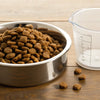How Much Dry Dog Food Per Day By Weight: A Comprehensive Guide for Pet Owners
- Houndsy
Table of Contents
- Introduction
- Understanding Daily Food Requirements
- How to Calculate Daily Food Amounts
- The Role of Food Quality
- How Houndsy Elevates the Dog Feeding Experience
- Conclusion
Introduction
Did you know that nearly 59% of dogs in the United States are overweight or obese? This staggering statistic highlights the critical importance of understanding how much dry dog food to feed our furry friends. As loving pet owners, we want to ensure our dogs are healthy, happy, and living their best lives. However, feeding our dogs the right amount of food is often more complicated than just following the guidelines on the dog food bag.
In this comprehensive guide, we’ll explore the factors that influence how much dry dog food our pets need daily based on their weight, age, activity level, and more. By the end of this post, readers will not only understand the importance of proper portion sizes but also learn how to adjust feeding amounts to suit their individual dog's needs. We will also discuss how our flagship product, the Houndsy Kibble Dispenser, can enhance this essential part of pet care by simplifying the feeding process and ensuring precise portion control.
Let’s dive into the key factors affecting how much dry dog food to feed our canine companions and discover how we can elevate their feeding experience.
Understanding Daily Food Requirements
When it comes to feeding our dogs, there’s no one-size-fits-all approach. Several factors determine how much dry dog food our pets should eat each day, including:
- Age: Puppies, adults, and senior dogs have different nutritional needs.
- Weight: The ideal weight for our dog plays a crucial role in determining portion sizes.
- Activity Level: Active dogs require more calories than less active ones.
- Breed: Larger breeds may need more food than smaller breeds.
- Health Status: Dogs with certain health conditions may require specific diets or adjusted food intake.
Let’s break down these factors in detail.
Age
Puppies, adults, and senior dogs each have distinct nutritional requirements. Puppies, for instance, are in a rapid growth phase and need more calories, protein, and nutrients to support their development. According to veterinary recommendations, puppies generally require about twice the calories per pound of body weight compared to adult dogs.
As dogs age, their metabolism slows, and they may become less active, leading to decreased caloric needs. Therefore, senior dogs often do better on lower-calorie diets to prevent obesity and promote overall health.
Weight
To accurately determine how much food to give our dogs, we should always refer to their ideal body weight rather than their current weight, especially if they are overweight or underweight. A simple way to gauge the ideal weight is by consulting with our veterinarian. For most healthy adult dogs, a general rule is to feed them about 2% to 4% of their body weight in food per day.
For example, a 50-pound healthy adult dog might require around 1 to 2 cups of dry food daily, but this amount can vary based on other factors.
Activity Level
Just like us, a dog’s activity level profoundly impacts their caloric needs. A dog that enjoys regular exercise will require more food than a dog that leads a sedentary lifestyle. For instance, a working dog, such as a Border Collie, may need up to 50% more calories than a couch potato Bulldog.
Breed
Different breeds have varying metabolic rates and energy levels. Larger breeds, like Great Danes and Labrador Retrievers, generally require more food than smaller breeds, such as Chihuahuas and Dachshunds. Moreover, certain breeds may have predispositions to obesity, so monitoring their food intake is essential.
Health Status
Health conditions, such as diabetes, allergies, or obesity, can significantly influence a dog's dietary needs. For example, overweight dogs may require a restricted-calorie diet to help them lose weight. Conversely, pregnant or nursing dogs require increased caloric intake to support their puppies.
Summary of Key Factors
- Age: Puppies need more calories; seniors need fewer.
- Weight: Use ideal weight to determine portion sizes.
- Activity Level: Active dogs need more food than sedentary ones.
- Breed: Larger breeds generally require more food.
- Health Status: Adjustments may be necessary based on specific health concerns.
How to Calculate Daily Food Amounts
Now that we understand the factors influencing our dog's feeding needs, let's look at how to calculate daily food amounts more precisely.
Step 1: Refer to Feeding Guidelines
The first step is always to check the feeding guidelines provided on the dog food packaging. These guidelines typically specify the recommended daily food intake based on weight and provide a feeding chart.
For instance, a common feeding guide might suggest:
- For dogs weighing 10-20 lbs: ¾ to 1 ⅓ cups daily
- For dogs weighing 30-50 lbs: 1 ¾ to 2 ⅔ cups daily
- For dogs weighing 60-100 lbs: 3 to 4 ½ cups daily
Step 2: Use Caloric Needs
A more accurate method is calculating the dog's caloric needs based on their Resting Energy Requirements (RER). The RER can be estimated using the following formula: [ RER = 70 \times (body weight in kg)^{0.75} ]
For example, a 22-pound (10 kg) dog would have an RER of: [ RER = 70 \times (10)^{0.75} ] [ RER ≈ 400 \text{ calories per day} ]
Once we have the RER, we can adjust this number based on the dog's activity level:
- Sedentary: RER × 1.2
- Active: RER × 1.5
- Highly active: RER × 2.0
Step 3: Adjust Based on Body Condition
After determining the daily caloric needs, we can then adjust the portion sizes according to the dog's current body condition. If the dog is overweight, we may reduce the daily intake by about 10-20%. If underweight, we may increase the intake similarly.
Example Calculation
Let’s say we have a 50-pound (approximately 23 kg) healthy adult dog:
- Calculate RER: [ RER = 70 \times (23)^{0.75} ] [ RER ≈ 400 \text{ calories per day} ]
- Adjust for Activity Level (assuming moderately active): [ Daily calories = RER \times 1.5 ] [ Daily calories ≈ 600 \text{ calories per day} ]
- Consult Feeding Guide: If the dog food provides 300 calories per cup, we would need: [ \frac{600 \text{ calories}}{300 \text{ calories/cup}} = 2 \text{ cups per day} ]
The Role of Food Quality
While understanding how much food to give is crucial, the quality of the food itself is equally important. High-quality dog food formulated with natural ingredients is more nutrient-dense, meaning our dogs can get the nutrients they need without consuming excessive amounts of food.
When choosing dog food, look for brands that prioritize quality and use whole ingredients rather than fillers. It's also beneficial to consult with a veterinarian to ensure that the chosen food meets our dog's specific needs.
How Houndsy Elevates the Dog Feeding Experience
As pet owners, we understand the importance of making the feeding ritual enjoyable and efficient. That’s where our flagship product, the Houndsy Kibble Dispenser, comes into play.
Benefits of the Houndsy Kibble Dispenser
- Convenience: Our dispenser allows for easy, standing-height access without the need to bend down, making feeding time more comfortable for both pets and their owners.
- Perfect Portion Control: With built-in portioning features, we can ensure that our dogs receive the right amount of food every time, reducing the risk of overfeeding.
- Stylish Design: The Houndsy Kibble Dispenser not only functions beautifully but also complements modern home decor, making it a stylish addition to our living spaces.
- Safety Features: The dispenser includes an auto-locking mechanism to prevent accidental dispensing—perfect for curious pets and toddlers alike.
- Large Storage Capacity: With the ability to store 25-30 lbs of kibble, we can easily keep our furry friends well-fed without frequent refills.
By integrating the Houndsy Kibble Dispenser into our feeding routine, we can elevate the experience of feeding our dogs while ensuring they receive the right amounts of high-quality food.
Conclusion
Feeding our dogs the right amount of dry dog food is essential for their health and well-being. By understanding the factors that influence their dietary needs—such as age, weight, activity level, breed, and health status—we can make informed decisions that keep our furry friends thriving.
With the right knowledge and tools, like the Houndsy Kibble Dispenser, we can simplify the feeding process and create a more enjoyable experience for ourselves and our pets. As we continue to care for our dogs, let’s remember the importance of portion control and quality nutrition.
FAQ
1. How will I know if I’m feeding my dog the right amount?
Monitoring your dog's body condition, weight, and overall health are key indicators. Consult your veterinarian if you're unsure about their ideal weight and caloric needs.
2. Can I free-feed my dog?
Free-feeding is generally not recommended as it can lead to overeating and obesity. Scheduled meals promote better weight management and a healthier lifestyle.
3. How often should I feed my dog?
Most adult dogs do well with two meals a day, while puppies may require three to four meals per day. Always adjust based on individual needs.
4. Is it okay to switch my dog’s food?
If considering a food change, it's best to do so gradually to avoid gastrointestinal upset. Always consult your veterinarian when making dietary changes.
5. How does the Houndsy Kibble Dispenser help with portion control?
The Houndsy Kibble Dispenser features built-in portioning capabilities that allow for accurate servings, ensuring our dogs receive the right amount of food every time without guesswork.
For more details on how to enhance your dog's feeding experience, visit the Houndsy Kibble Dispenser product page and discover how we can help you elevate this essential part of pet care.












